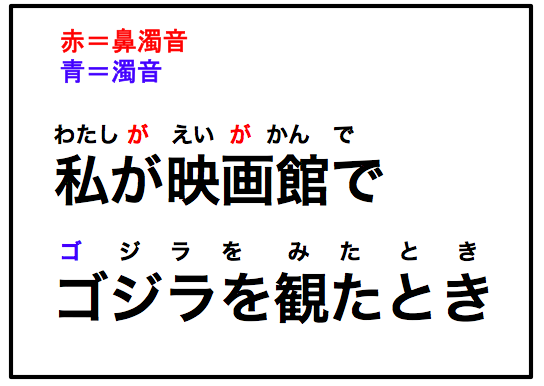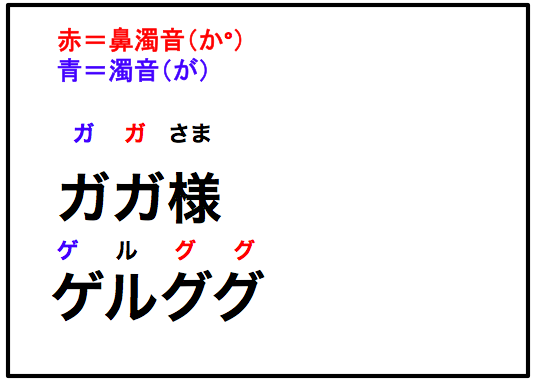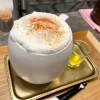
Wait, what? These weren’t in chapter one of Genki….
If you’ve studied Japanese, then chances are you’ve seen the voicing marks (tenten in Japanese) that go above some hiragana. You’ve also probably encountered the little circles (maru in Japanese) that go above the hiragana for ha, hi, fu, he, ho, turning them into pa, pi, pu, pe, po.
But something you might’ve never seen before is the little circles being used with other hiragana, namely ka, ki, ku, ke, ko.
▼ Everything I thought I knew about Japanese is a lie….
They may look a little strange to learners of Japanese. How would you even pronounce them? P-ha, p-hi, p-fu?
Nope! These weirdos represent voiced nasal sounds and are pronounced similar to: nga, ngi, ngu, nge, ngo.
▼ Skip to 0:30 in this video to have a nice man in a hat pronounce the difference between the normal ga, gi, gu, ge, go and nga, ngi, ngu, nge, ngo.
https://www.youtube.com/watch?v=0eexu2ix-po
Okay, so that’s great and all, but where are these hiragana used? And if they’re so cool, why aren’t students of language ever taught them?
Good questions! These voiced nasal sounds are mostly exclusive to the Eastern dialect of Japan in the Kanto and Tohoku regions (Tokyo, Fukushima, Aomori, etc.). In the Western regions (Hiroshima, Kyushu, etc.), the voiced nasal sounds don’t exist, and they somehow get along just fine with only ga, gi, gu, ge, go.
Since Tokyo Japanese is considered “standard” Japanese, news anchors and announcers have to go through rigorous voice training programs to ensure that they’re giving the “correct” nasal touch to their voiced sounds.
So if you want to sound like a fancy Tokyo-ite, then here’s a handy guide to when your ga, gi, gu, ge, gos should turn into nga, ngi, ngu, nge, ngos:
▼ Red represents the voiced nasal (ng),
and blue represent the normal voiced (g).
▼ The voiced nasal is used for the particle ga, and for every
ga, gi, gu, ge, go sound that doesn’t come at the beginning of a word.
Aside from those undergoing announcer training though, most Japanese people never encounter these bizarre-looking hiragana, and that’s why students of Japanese aren’t taught them.
It makes sense though; in the U.S., we don’t usually take dialect differences into account when spelling English either: “aunt” is spelled the same even in places that pronounce it as “ant,” and “soda” is spelled the same even in places that pronounce it as “pop.”
According to Japanese linguists, the voiced nasal has been slowly dying off, being replaced by the normal voiced sounds that we’re all familiar with. At this rate it might not be too much longer before they’re extinct sounds.
▼ Skip to 1:40 to see how the red circles (normal g) has been invading from the west to take over the green circles (nasal ng) over the past 50 years.
Personally I know that whenever I use the voiced nasals, I just feel like I sound pretentious, so I usually keep them hidden away in my nose. But what do you do when you speak Japanese? Were you taught to use the voiced nasals? If so, let loose with some in the comments, so we can preserve their nasal-y beauty for all eternity.
References: NHK Online, Notre Dame Seishin University
Images: ©RocketNews24
[ Read in Japanese ]



 Learn Japanese through ridiculous manga: A Tick on Titan 【Episode #3】
Learn Japanese through ridiculous manga: A Tick on Titan 【Episode #3】 Learn Japanese through ridiculous manga: Fullmedal Alchemist 【Episode #5】
Learn Japanese through ridiculous manga: Fullmedal Alchemist 【Episode #5】 Learn Japanese through ridiculous manga: Dragon Bowl【Episode #4】
Learn Japanese through ridiculous manga: Dragon Bowl【Episode #4】 Learn Japanese through ridiculous manga: Death Vote 【Episode #6】
Learn Japanese through ridiculous manga: Death Vote 【Episode #6】 How do you pronounce “Among Us” in Japanese? Simple question has linguistically deep answer
How do you pronounce “Among Us” in Japanese? Simple question has linguistically deep answer Japanese beef bowl chain Sukiya’s 2026 Smile Box lucky bag basically pays for itself
Japanese beef bowl chain Sukiya’s 2026 Smile Box lucky bag basically pays for itself Serpentine Winnie the Pooh Year of the Snake plushies, Mickey and Baymax daruma arrive in Japan
Serpentine Winnie the Pooh Year of the Snake plushies, Mickey and Baymax daruma arrive in Japan Cappuccino Ramen becomes super popular in Japan, but is it worth the hype?
Cappuccino Ramen becomes super popular in Japan, but is it worth the hype? Haunted hospital near Mt Fuji re-opens after renovation at Fuji-Q Highland, and it’s terrifying
Haunted hospital near Mt Fuji re-opens after renovation at Fuji-Q Highland, and it’s terrifying We go behind the scenes at Japan Airlines’ in-flight meal factory【Photos】
We go behind the scenes at Japan Airlines’ in-flight meal factory【Photos】 Shrimp nuggets returning to McDonald’s Japan menu with a special surprise
Shrimp nuggets returning to McDonald’s Japan menu with a special surprise How to travel from Tokyo to Kyoto on the overnight bus and not lose your sanity
How to travel from Tokyo to Kyoto on the overnight bus and not lose your sanity 26 scenes from one of the liveliest Coming of Age Day celebrations in Japan 【Photos】
26 scenes from one of the liveliest Coming of Age Day celebrations in Japan 【Photos】 Pizza Hut Japan’s hot lucky bags are perfect for a New Year’s pizza party
Pizza Hut Japan’s hot lucky bags are perfect for a New Year’s pizza party Japan has an awesome one-person bento box rice cooker, and here’s what we made with ours
Japan has an awesome one-person bento box rice cooker, and here’s what we made with ours Starbucks Japan ready to get Year of the Horse started with adorable drinkware and plushies【Pics】
Starbucks Japan ready to get Year of the Horse started with adorable drinkware and plushies【Pics】 7 great places to see Mt. Fuji from without having to climb it
7 great places to see Mt. Fuji from without having to climb it Cyberpunk anime meets traditional culture in Ghost in the Shell gold leaf Japanese changing screens
Cyberpunk anime meets traditional culture in Ghost in the Shell gold leaf Japanese changing screens Hayao Miyazaki says Happy New Year to Studio Ghibli fans with new art for Year of the Horse
Hayao Miyazaki says Happy New Year to Studio Ghibli fans with new art for Year of the Horse Hello Kitty Choco Egg figures are an adorable trip through three periods of Japanese pop culture【Pics】
Hello Kitty Choco Egg figures are an adorable trip through three periods of Japanese pop culture【Pics】 We found possibly the quietest Japanese-style hotel in Tokyo’s bustling Shinjuku district
We found possibly the quietest Japanese-style hotel in Tokyo’s bustling Shinjuku district 7-Eleven Japan’s ramen-cooking robot whipped us up a bowl of noodles【Taste test】
7-Eleven Japan’s ramen-cooking robot whipped us up a bowl of noodles【Taste test】 Sumo Sanrio! Hello Kitty and pals team up with Japan Sumo Association for new merch【Pics】
Sumo Sanrio! Hello Kitty and pals team up with Japan Sumo Association for new merch【Pics】 Japan’s oldest largetooth sawfish in captivity back on display in Mie Prefecture
Japan’s oldest largetooth sawfish in captivity back on display in Mie Prefecture More Than a Capsule Stay: Why Solo Travelers Choose “global cabin Yokohama Chinatown”
More Than a Capsule Stay: Why Solo Travelers Choose “global cabin Yokohama Chinatown” 7-Eleven Japan starts new temporary luggage storage service in over 300 branches
7-Eleven Japan starts new temporary luggage storage service in over 300 branches Disillusionment at Tsukiji’s tourist-target prices led us to a great ramen restaurant in Tokyo
Disillusionment at Tsukiji’s tourist-target prices led us to a great ramen restaurant in Tokyo Starbucks teams up with 166-year-old Kyoto doll maker for Year of the Horse decorations【Photos】
Starbucks teams up with 166-year-old Kyoto doll maker for Year of the Horse decorations【Photos】 Tokyo considering law requiring more trash cans following litter increase in heavily touristed area
Tokyo considering law requiring more trash cans following litter increase in heavily touristed area Tokyo’s Tsukiji sushi neighborhood asks tour groups to stay away for the rest of the month
Tokyo’s Tsukiji sushi neighborhood asks tour groups to stay away for the rest of the month Tokyo event lets you travel back in time, for free, to celebrate 100 years since Showa era start
Tokyo event lets you travel back in time, for free, to celebrate 100 years since Showa era start Sanrio theme park in Japan announces plans to expand into a Sanrio resort
Sanrio theme park in Japan announces plans to expand into a Sanrio resort Japan may add Japanese language proficiency, lifestyle classes to permanent foreign resident requirements
Japan may add Japanese language proficiency, lifestyle classes to permanent foreign resident requirements Stamina-destroying “Paralysis Noodles” are Tokyo’s newest over-the-top ramen innovation
Stamina-destroying “Paralysis Noodles” are Tokyo’s newest over-the-top ramen innovation Survey asks foreign tourists what bothered them in Japan, more than half gave same answer
Survey asks foreign tourists what bothered them in Japan, more than half gave same answer Japan’s human washing machines will go on sale to general public, demos to be held in Tokyo
Japan’s human washing machines will go on sale to general public, demos to be held in Tokyo Japan’s deadliest food claims more victims, but why do people keep eating it for New Year’s?
Japan’s deadliest food claims more victims, but why do people keep eating it for New Year’s? We deeply regret going into this tunnel on our walk in the mountains of Japan
We deeply regret going into this tunnel on our walk in the mountains of Japan Studio Ghibli releases Kodama forest spirits from Princess Mononoke to light up your home
Studio Ghibli releases Kodama forest spirits from Princess Mononoke to light up your home Major Japanese hotel chain says reservations via overseas booking sites may not be valid
Major Japanese hotel chain says reservations via overseas booking sites may not be valid Put sesame oil in your coffee? Japanese maker says it’s the best way to start your day【Taste test】
Put sesame oil in your coffee? Japanese maker says it’s the best way to start your day【Taste test】 No more using real katana for tourism activities, Japan’s National Police Agency says
No more using real katana for tourism activities, Japan’s National Police Agency says Starbucks Japan reveals new sakura drinkware collection, inspired by evening cherry blossoms
Starbucks Japan reveals new sakura drinkware collection, inspired by evening cherry blossoms Updated cherry blossom forecast shows extra-long sakura season for Japan this year
Updated cherry blossom forecast shows extra-long sakura season for Japan this year The science behind why English speakers can’t pronounce the Japanese “fu”
The science behind why English speakers can’t pronounce the Japanese “fu” The surprising reasons why some hiragana aren’t allowed to be used on Japanese license plates
The surprising reasons why some hiragana aren’t allowed to be used on Japanese license plates Why does Japanese writing need three different sets of characters? (Part 2)
Why does Japanese writing need three different sets of characters? (Part 2) World’s first moaning hiragana character either a stroke of genius or just plain weird【Video】
World’s first moaning hiragana character either a stroke of genius or just plain weird【Video】 Why does Japanese writing need three different sets of characters? (Part 1)
Why does Japanese writing need three different sets of characters? (Part 1) Japanese writing system gets turned into handsome anime men with Hiragana Boys video game
Japanese writing system gets turned into handsome anime men with Hiragana Boys video game The top 10 hardest Japanese words to pronounce – which ones trip you up?【Video】
The top 10 hardest Japanese words to pronounce – which ones trip you up?【Video】 Japanese elementary school student teaches us all how to pronounce English like a native speaker
Japanese elementary school student teaches us all how to pronounce English like a native speaker Magazine teaches Japanese using Kemono Friends anime, Japanese netizens can’t stop laughing
Magazine teaches Japanese using Kemono Friends anime, Japanese netizens can’t stop laughing Learn Japanese through ridiculous manga: Narutoe 【Episode #2】
Learn Japanese through ridiculous manga: Narutoe 【Episode #2】 One simple kanji character in super-simple Japanese sentence has five different pronunciations
One simple kanji character in super-simple Japanese sentence has five different pronunciations The reason why Japanese students don’t pronounce English properly
The reason why Japanese students don’t pronounce English properly Seven mistakes foreigners make when speaking Japanese—and how to fix them
Seven mistakes foreigners make when speaking Japanese—and how to fix them Pronunciation anxiety: many Japanese people don’t want to speak English unless it’s “perfect”
Pronunciation anxiety: many Japanese people don’t want to speak English unless it’s “perfect” Let’s learn how to sing “Jingle Bells” in Japanese with the help of Santa Pikachu!【Video】
Let’s learn how to sing “Jingle Bells” in Japanese with the help of Santa Pikachu!【Video】
Leave a Reply